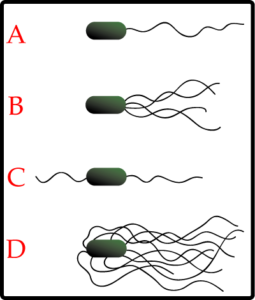
Courses

By Shailendra Singh
|
Updated on 16 Dec 2024, 14:59 IST
Flagella are small hair-like structures involved in cell movement. The word flagellum means whip.
Flagella have a whip-like appearance that helps to keep the cell in the fluid. Some special flagella are used in a number of living things such as sensory organs that can sense changes in pH and temperature.
They are filamentous structures found in archaea, bacteria, and eukaryotes.

Flagella is a helical structure made up of flagellin proteins. The structure of the flagella is divided into three parts:
It consists of rings surrounded by a pair of proteins called MotB. Rings include:
Ihuku
A structure is similar to thin hair from a point.

One flagellum at one end or another. These are known as polar flagellum and can rotate clockwise and counterclockwise. Clockwise movement moves the living one forward while the opposite movement of the clock pulls it backward.
Several flagella are attached to the rest of the body. These are not polar flagella because they are found throughout the body. These flagella rotate opposite the clock and form a mass moving one organism in one direction. When another flagella breaks and begins to spin like a clock, the organism does not move in any direction and begins to fall.
Several flagella at the end of one living thing or another. These are known as polar flagellum and can rotate clockwise and counterclockwise. Clockwise movement moves the living one forward while the opposite movement of the clock pulls it backward.
One flagellum in both ends of living organisms. These are known as polar flagellum and can rotate clockwise and counterclockwise. Clockwise movement moves the living one forward while the opposite movement of the clock pulls it backward.
Flagella performs the following functions:
It is grouped in the protozoans, Ciliata class, in the Ciliated epithelium of Metazoa, and other classes.

It is usually present on the outer surface of the body such as the caterpillar Mollusca, Annelida, and Nemertines, thus helping to escape.
It has structures and functions similar to those of the flagella, but the cilium is shorter and the movement is very different.
These are present in protozoans, Metazoa choanocyte cells, and in other classes – in plants, gamete cells, and algae.
A centriole is a cylindrical structure made up of microtubules, found in the cytoplasm of animal cells. It is located near the nucleus in a region called the centrosome. The primary function of centrioles is to assist in cell division. During mitosis and meiosis, centrioles help organize the microtubules that form the spindle apparatus, which is responsible for separating the chromosomes into the daughter cells. Centrioles also play a role in the formation of cilia and flagella, which help in cell movement and fluid movement on the cell surface.
Centrioles play a key role in the formation of the spindle apparatus during cell division (mitosis and meiosis). They organize microtubules to ensure the proper alignment and separation of chromosomes into two daughter cells. Centrioles also contribute to the formation of cilia and flagella, which are involved in cell movement and the movement of fluids over the cell surface.
In Class 11 biology, a centriole is introduced as a vital component of the cell’s structure, specifically involved in cell division. It is a microtubule-based structure found in the centrosome of animal cells. Centrioles help form the spindle fibers during mitosis and meiosis, ensuring chromosomes are properly separated between daughter cells. Centrioles also play an essential role in the formation of cilia and flagella, which are important for cellular movement and locomotion.